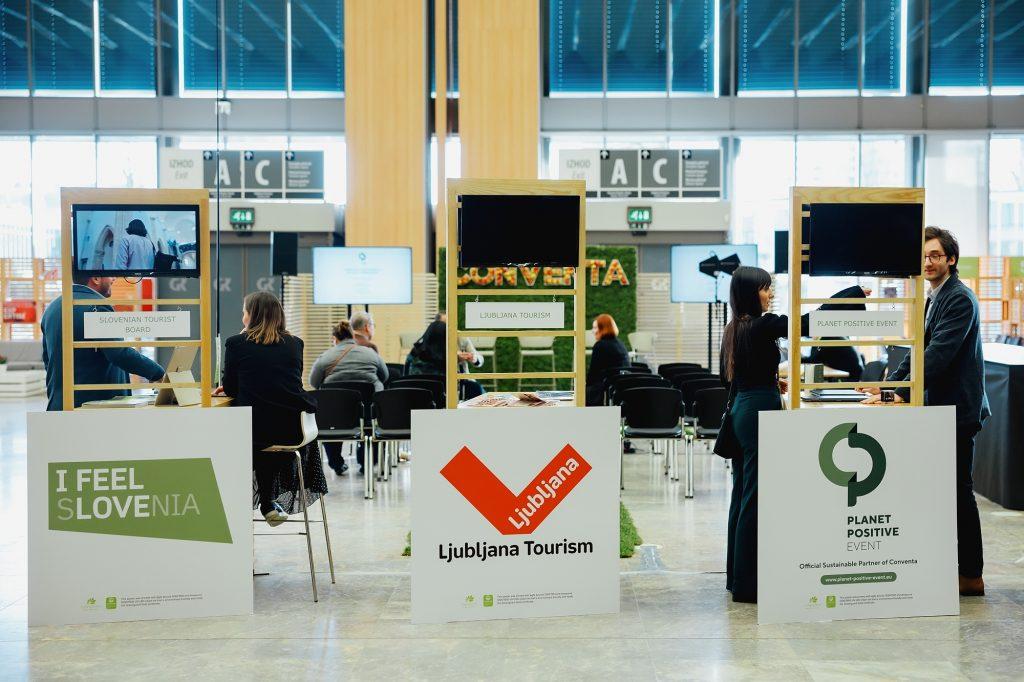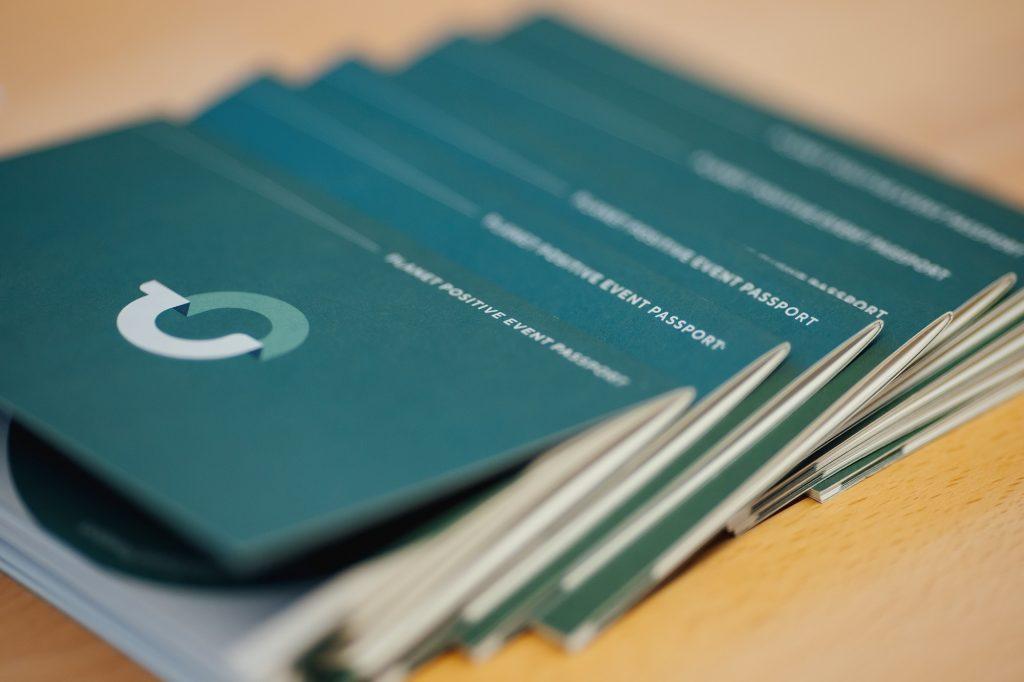What we learned from measuring the carbon footprint of Conventa 2022 – 2024
Conventa is among a handful of trade shows that consistently and systematically measure its carbon footprint. The organisers transparently share the results of the measurements in line with the sustainability pledge. After three years of measuring the carbon footprint and testing several methodologies, the organisers have found the most suitable approach for measuring an event’s sustainability.
Why do we even measure Conventa’s carbon footprint? The organisers effortlessly identify with the reasons listed by Umanotera, a Slovenian NGO specialised in environmental preservation that applies to events in general, and especially Conventa:
- we wish to manage our emissions more precisely and plan measures to reduce emissions;
- we want to benchmark with companies and organisations within our sector and industry;
- we need the carbon footprint calculation to report to our partners;
- we want to avoid the risks created by soaring prices of fossil fuel and carbon;
- we use the carbon footprint calculation as a communication tool.
We also agree with Umanotera that measuring the carbon footprint is only the beginning. The actual purpose of calculating the carbon footprint is to prepare a detailed annual sustainability action plan, which would be impossible without the measurement.

The calculated carbon footprint depends on the accuracy of the collected data. We rely on the data sent to us by our partners and all subcontractors. That is why we calculate the accuracy of all collected data. The accuracy is based on the following scale:
5 – highly accurate: all information comes from precise measurements and proof, such as paid invoices.
3- moderately accurate: some information was measured, and other information was evaluated approximately.
1 – inaccurate: almost all sent data was approximately evaluated.
Based on the accuracy of the data, we set the safety margin. The threshold for an event’s safety margin is 3.01. The criteria for setting the safety margin:
- +0 % Safety margin, if more than 51% of acquired data about the accuracy of information is ranked as moderately accurate or highly accurate (a mark higher than 3.01)
- +5 % Safety margin, if more than 50% of collected information is moderately accurate or inaccurate (a mark between 2.01 and 3.00).
- + 10% Safety margin, if more than 50% of collected information is moderately accurate or inaccurate (mark lower than 2.01).
The final measurement correlated to the accuracy of collected data during the past three carbon footprint calculations at Conventa. That is most evident in mobility. In 2022, we calculated data about mobility only based on the number of attendees and an approximate measurement of their travels. Conversely, in 2023 and 2024, we precisely calculated the journey for every attendee, employee and supplier and segmented the data depending on the type of transportation and fuel. Measuring data for each individual is crucial because the carbon footprint generated by mobility amounts to 77.2% of the 88.2% of the overall carbon footprint. The credibility of the entire calculation depends on the collected data. The table below compares the carbon footprint of Conventa with the calculation for mobility:
| Safety Margin | Overall carbon footprint in kgCO2 | Mobility in kgCO2 | Percentage of the mobility carbon footprint | |
| Conventa 2022 | 1.99 | 250,408 | 220,765 | 88.2% |
| Conventa 2023 | 3.03 | 116,425 | 97,141 | 83.4% |
| Conventa 2024 | 3.56 | 116,409 | 83,995 | 72.2% |
The difference in the final calculations is also the various methodologies we used. We calculated the data according to Climate Partner’s methodology during the first two years. In 2024, however, we measured it using the novel methodology of Planet Positive Event. In both instances, the emission factors were aligned with the GHG Protocol and based on the UK DEFRA’s indexes (The Department for Environment, Food and Rural Affairs). What separates this measurement from the first year’s is that we measured the use of energy and water and the amount of waste at the event much more precisely. Planet Positive Event’s calculator also includes data about the carbon footprint generated by communication, marketing, event production and social responsibility.

Planet Positive Event’s methodology enables us to obtain a detailed insight into the results of the measurement in line with the GHG Protocol, which segments emissions into three scopes:
Scope 1: Direct greenhouse (GHG) emissions that occur from sources that are controlled or owned by an organisation (e.g., emissions associated with fuel combustion in boilers, furnaces, and vehicles).
Scope 2: Indirect GHG emissions associated with the purchase of electricity, steam, heat, or cooling. This scope includes emissions within the electroenergetic grid when distributing electric energy.
Scope 3: Indirect GHG emissions that arise in the value chain of an organisation. This data is most difficult to track and control, even though it represents the greatest percentage of an organisation’s emissions. These include data connected to suppliers, business trips, purchases, waste, water use and data about the life cycle of products and services.
Here are the results for Conventa 2024:
| CO2 in kg | Percentage | |
| SCOPE 1: DIRECT EMISSIONS | 9,123.25 | 7.84% |
| Project management and communication | 657.36 | 0.56% |
| Energy use in the project office | 8,050.60 | 6.92% |
| Waste in the project office | 152.99 | 0.13% |
| Water use in the project office | 34.15 | 0.03% |
| Purchasing | 228.15 | 0.20% |
| SCOPE 2: INDIRECT EMISSIONS | 6,385.53 | 5.49% |
| Energy use by venues | 5,970.53 | 5.13% |
| Energy use by catering companies | 41.00 | 0.36% |
| SCOPE 3: OTHER INDIRECT EMISSIONS | 101,088.01 | 86.84% |
| Mobility of all groups of attendees | 77,388.45 | 66.48% |
| Mobility of coworkers and suppliers | 6,607.53 | 5.68% |
| Event production | 513.24 | 0.44% |
| Direct waste at the event | 1,116.37 | 0.96% |
| Direct water use at the event | 11.97 | 0.01% |
| Reusing wooden exhibition crates (3137 crates) | 151.12 | 0.13% |
| Reusing heuga carpets (1680 volumes) | 32.56 | 0.03% |
| Catering – food | 2,334.99 | 2.01% |
| Catering – beverages | 552.17 | 0.47% |
| Hotel accommodation | 12,192.47 | 10.47% |
| OVERALL CARBON FOOTPRINT OF CONVENTA 2024: | 116,409.65 | 100.00% |
Expectedly, the greatest part of the carbon footprint calculation came from direct emissions, predominantly because of participants’ travels. The fact that the event’s preparation phases came between October and February affected the final carbon footprint. Consequently, energy use for heating skyrocketed. Planet Positive’s criteria offer tips to event organisers by pointing them to the segments where they can reduce their carbon footprint the most. It is important to note that organisations can achieve a great deal in minimising direct emissions. Each activity has an impact in the end. This year, we realised that heating and energy use in our office was catastrophic. As the event takes place in winter, we can reduce the overall carbon footprint by 4% by improving and optimising energy use.
To summarise the carbon footprint of Conventa 2024, the five main sources of Conventa’s carbon footprint are:
72.16% Mobility
12.40% Energy
10.47% Hotel accommodation
2.48% Catering
1.13% Waste and water
In the future, we will focus on reducing the carbon footprint in these segments and include measures to reduce them in the action plan.
RECOMMENDATIONS FOR GREEN MANAGERS WHO WANT TO SUCCESSFULLY MEASURE THEIR CARBON FOOTPRINT EFFECTIVELY
We have learned tremendously about data gathering in three years. We have selected a few practical tips and tricks:
1. PROJECT OFFICE: The basis for calculating the carbon footprint generated in an office space is to accurately and systematically follow the monthly expenses of electricity, energy use, municipal waste fee, water use and internet costs. We recommend you calculate the monthly expenses per employee and per square metre of your office.
2. COMMUNICATION: In communication, the predominant carbon footprint emissions sources are direct marketing, websites and social media platforms. We suggest you measure and systematically collect at least the following data:
- Number of website views, sessions and unique visitors
- Number of searches in Google, Bing, Yahoo, etc.
- Number of sent individual e-mails
- Number of sent e-newsletters
If your event is a hybrid conference, you must also measure the carbon footprint of the streaming.
3. MOBILITY: We suggest you track transport and meticulously measure it. Given transport generates the most carbon footprint, informational support is crucial. Imprecise and approximate evaluations can increase the final carbon footprint calculation by over 30%.
4. MOBILITY: You should collect data about how attendees come to the event before they arrive or at least when they register. After the event, it will be too little, too late. From experience, we can say it is demanding to gather the data post-event. The minimal data you must collect includes:
- location attendee comes from
- location attendee will return to
- type of transport
- type of fuel
- distance in kilometres
5. PURCHASING AND ORDERING SERVICES: We advise that you systematically collect and regularly follow delivery notes and their emission factors. You should always require the suppliers to provide you with certificates that you can include in the final event report. It starts with the paper itself, where you should urge them to obtain the FSC or PEFC certificates. The same applies to the most complex tech gadgets and products, including computer equipment with the Energy Star certificate.
6. VENUES: Energy use by far represents the highest percentage of venues’ carbon footprint. That is why it is pivotal to acquire detailed information about energy use in event halls from the venues. If they do not measure the data for each hall, they should at least provide information about the venue’s overall energy use and heating numbers (suppliers’ delivery notes) and how many surfaces were used.
7. VENUES: Approximate calculations are used only when a venue has just started operating, has not collected data yet and only has information about the monthly energy use. In that case, the energy calculation can be something like this:
- Event duration: 5 hours
- Used surface area: 250 square metres
- Total surface: 1500 square metres
- Use of energy per month and day: 10,000 kWh/322,58 kWh
Overall energy use calculation: (250/1500)x(5/24)x322.58 = 11.20 kWh

8. CATERING: It is crucial to distinguish between the following terms to calculate the carbon footprint of catering:
Meal – food served at the event that combines several dishes and ingredients and can be vegetarian, vegan, pescetarian or meat.
Dish – an individual dish served at an event that comprises various ingredients.
Ingredients – the foods or substances that comprise a dish.
9. CATERING: An overview of emission factors for typical meal ingredients (kgCO2e/kg)
– beef 0,03903 kgCO2e/g
– cheese 0,01107 kgCO2e/g
– chicken 0,00697 kgCO2e/g
– rice 0,00367 kgCO2e/g
– legumes 0,00147 kgCO2e/g
– peppers 0,00138 kgCO2e/g
– apple 0,00038 kgCO2e/g
Emission factors should guide you when assembling the menus. We recommend 70% of your dishes to be plant-based.
10. ACCOMMODATION: The data for calculating the carbon footprint is the number of overnight stays. The emission factor is calculated based on the generally accepted Cornell Hotel Sustainability Index (CHSB). We recommend you carefully write down the number of overnight stays and, whenever possible, acquire primary data from the hotel, including data about energy use, water use and waste per hotel room.
You can simplify your carbon footprint measurement with the help of Planet Positive Event forms for calculating carbon footprint. They represent the first forms of their kind in the world, helping you collect data effortlessly. You can find more information at: https://planet-positive-event.eu/.
The Planet Positive Event methodology clearly shows we can do much more than recycle name badges and plant trees. Convincing ourselves that we are making improvements while actually stagnating does not solve the multifaceted issues of sustainably transforming the meetings industry.
That is one of the reasons why Planet Positive Event includes an SDG Matrix that covers all 17 SDG goals. The pioneering tool thus recognises and addresses the regenerative effects of events. That is why the tool is a game-changer, enabling events to transform sustainably. Of course, event organisers must first measure their carbon footprint.

The know-how we gained at Conventa during the last carbon footprint measurement is priceless. It has enabled us to obtain a realistic picture and acquire new knowledge that will help advance the entire industry. At the same time, we can develop new skills and techniques while measuring the development of our innovative approach.
By comparing various approaches and methodologies for measuring carbon footprint and collecting data, we succeeded in calculating a credible carbon footprint of the event after three years. External assessors will also check how much the event complies with the ESRS Standards.


